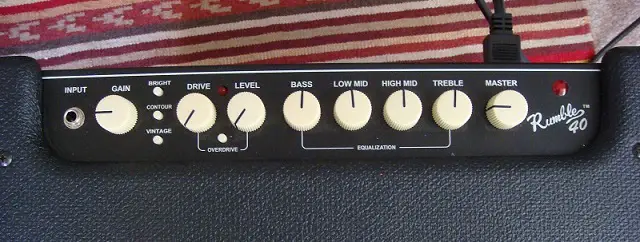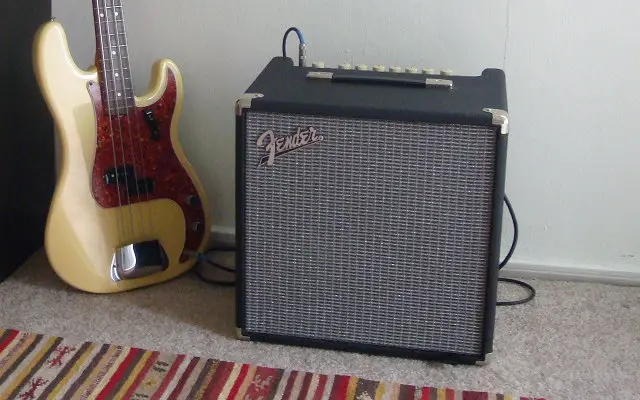After picking up a Fender Rumble Bass Amp, I thought it would be a good idea to write a review about it. To be totally honest, I had never been a big fan of the Rumble series amps in the past. I always thought they sounded kind of sterile. And, I wasn’t in love with the looks either. However, while browsing through the music store a while back, I noticed that Fender had a new series of Rumble amps, and it immediately caught my eye.
Fender offers several different models with a wide range of sizes and power to choose from. I was looking for a good-sounding practice amp that I could use on small jams, so I opted for the Fender Rumble 40. It has 40 watts running through a 10” speaker with 2 front-mounted ports.
Fender Rumble bass amp details
The Size and Styling
The first thing I noticed was the styling. These amps have that classic 1960s / 70s design you usually only see on guitar amps. Classic black Tolex outer covering that is removable, simple, elegant and very cool looking. The controls are on top at the back, and I was surprised at how many there were (8 knobs and 4 buttons), especially for a small budget amp. The next thing that I tried was picking it up…and this is where I was completely dumbfounded.
Amp weight is an important factor to most bass players, and even small bass amps can be kind of heavy. The Fender Rumble 40 is an extremely light amp. When I first lifted it I thought that maybe this was a dummy model, just for display. It felt like there was nothing inside the thing. I used to own a small Fender Bassman 25 amp that I loved, and I thought that was light, but this Rumble amp felt half as heavy. It turns out the Fender Rumble 40 is only 18 pounds, which is very light. Most amps that I have owned in this size range were around 35 – 50 lbs. So far so great, but what about the sound?
The Sound
My biggest fear when I plugged into the Rumble was that it was going to sound like the old ones. I always felt that those older models had a somewhat flat, sterile tone with too much mid-range bark and not enough in the bottom end…and turning up the bass knob just made muddiness. But, the new Rumble series sounds totally different.
Fender has completely re-engineered the electronics, and they did it right. With all the controls set flat, the amp has a nice vintage punch and plenty of
The Rumble has a pleasingly warm, tube-like tone that reminded me of my Ampeg BA112 only with a little more of that classic Fender bark in the mid-range. With the rounds, I noticed more punch and grind at the top, which is to be expected. The P-Bass with rounds sounded full and punchy through the Rumble and the Jazz had that bright focused tone with a smooth, vintage vibe.
My favorite though was my P-Bass with flats and all controls at noon. The flats gave it more beef in the low-mid range and sweetened the highs. The smooth, deep tone reminded me of many ’70s era bass sounds. It seems this little amp was made for a

The electronics
The parametric EQ offers bass, low-mid, high mid, and treble knobs. There are also gain and master volume controls. There are 3 preset button selectors: Bright (boosts highs), contour (cuts mids), and vintage (boosts lows, cuts highs). Although these selectors are nice to have, I didn’t find them super useful as I thought it was easier to just dial in the right tone myself with the EQ.
There’s also an overdrive selector that has a drive and a level knob. I wasn’t super impressed with it, but for an
Fender Rumble bass amp – Final Thoughts
I think the Fender Rumble 40 is perfect for a small lightweight practice amp that could also be used for coffee shop type gigs. One small quibble with the knobs: Some of them turn too freely, which can be annoying if you just brush one and it turns out of position. However, I do appreciate the detents at noon and they do feel solid. It would also be nice if the power switch was on top of the amp instead of on the back. Overall this amp is a winner, and I recommend it to anyone looking for a good small amp, regardless of your budget. If I was in the market for it, I would not hesitate to buy a larger, more powerful model. I am really curious about the 200 and 500-watt versions, but I will leave that for another review.

